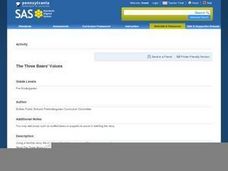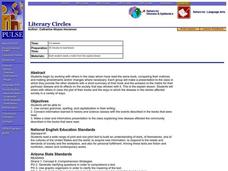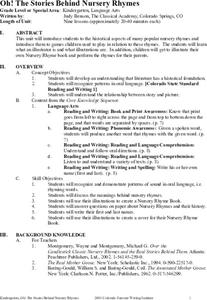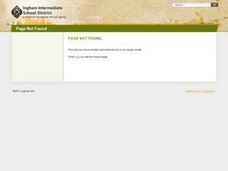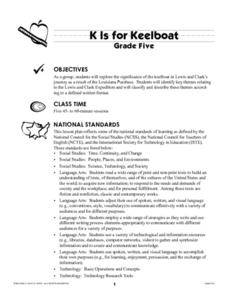Curated OER
Teaching Fluency Using Readers Theatre
Third graders listen as their teacher reads them a book. In groups, they are given a story and time to practice a skit. After taking suggestions from their teacher, they perform their skit and receive feedback from the class. They can...
Curated OER
Time for All Ages
Fourth graders discover time keeping by analyzing technological advances in history. In this time lesson, 4th graders create and complete a KWL chart based on their research of a famous timekeeping invention, such as a sundial....
Curated OER
There Was An Old Lady...
First graders read "There Was An Old Lady Who Swallowed a Fly" and use Kid Pix to identify characters from the story. For this character identification lesson, 1st graders first hear several versions of the classic tale, and then locate...
Curated OER
Romeo and Juliet Promptbook - The Balcony Scene
In this Romeo and Juliet worksheet, students view three versions of the balcony scene. Students discuss why the director chose the elements for the film versions. Students then complete a prompt-book activity analyze the setting,...
Planet e-Book
The Great Gatsby
The Great Gatsby has become one of the most iconic novels in American literature. An eBook allows readers to access the full text of the novel by F. Scott Fitzgerald. With the original words and paragraph breaks intact, new generations...
Scholastic
Wrapping Up the School Year
Students complete a variety of writing and yearbook activities to complete the school year. They write a letter to the student that will sit in their desk the next school year, and a letter to their next year's teacher. As a culminating...
Curated OER
Today is Monday Lesson Plan
Students read a book and recite the days of the week in a story. In this instructional activity about the days of the week, students which become familiar with the parts of the day. Students read Today is Monday, and situate the days of...
Curated OER
Learning About Emotions
Students participate in a series of activities about identifying different feelings and emotions. In these oral language and discussion lessons, students use pictures and photographs to get them involved in oral storytelling activities....
Curated OER
Introduce Vocabulary: Clifford the Big Red Dog
Students explore English by reading a classic story in class. In this story vocabulary lesson, students read the book Clifford the Big Red Dog and identify the use of specific vocabulary words. Students define the certain vocabulary...
Curated OER
The Three Bears' Voices
Students explore language arts by reading a classic story. In this oral storytelling lesson, students read the book The Three Bears and identify the characters and discuss how their voices would sound. Students practice retelling the...
Curated OER
Teach Text Features & Read Nonfiction
Elementary schoolers examine the components of reading nonfiction. They use think-alouds to help them complete reading the selected sections. They also identify text features as they read.
Curated OER
Folktale Unit: The Princess and the Golden Shoes
Young scholars study variations of classic folktales while deciding why the tales were so popular many years ago. They write a letter to an author.
Curated OER
Fables With Dolch Sight Words
Second graders read classic fables, consider their meaning and then re-write them using a prompt if necessary. This lesson plan presents many classic fables that students can read, and re-write, using their powers of imagination.
Curated OER
Historical Puppet Play
Fourth graders analyze the book Train to Midnight, based on the Underground Railroad. They compose and perform a puppet play based on the book. Students perform and videotape their puppet plays.
Curated OER
The Lion, The Witch, and The Wardrobe: A Literature Evaluation Project
Sixth graders read and analyze The Lion, The Witch, and The Wardrobe. They study the elements of literature found in the book. Students create an elements of literature flip book that shows the various elements of literature in the novel.
Curated OER
Literary Circles
Students use correct grammar, spelling and capitalization in their writing. They connect information acquired in history and science classes with the events described in the books that were read. Students make a clear and informative...
Curated OER
Time to Read
Students identify how the literary elements of theme, point of view, characterization, setting, and plot illustrate the effects of a certain disease on a community. They identify the aspects of the book that are specific to the...
Curated OER
Constellations
Learners explore constellations. They read trade books about constellations and write notes including their locations, origins, and names. They research and report on one constellation in the Northern Hemisphere and share their report...
Curated OER
What Makes Good Literary Writing?
Students conduct a literature study of John Steinbeck's classic "Of Mice And Men". They write in reflection of the author's influence upon 20th century literature. Students take apart the story to focus class discussion upon major themes...
Curated OER
Oh! The Stories Behind Nursery Rhymes
Students investigate the games that children used to play to nursery rhymes. They explore the role of illustrators and illustrate their own book of rhymes in this unit.
Curated OER
Grab Hands and Run: Understanding Human Rights
Sixth graders read the novel Grab Hands and Run by Frances Temple. They explore the effects of war on human rights. Students explore the idea that human rights are protected by the United Nations. They identify the human rights that were...
Curated OER
The Emperor and the Kite
Fourth graders explore storytelling by reading a classic story. In this vocabulary identification lesson, 4th graders read the story The Emperor and the Kite and define the different vocabulary terms that appear in the story. Students...
Curated OER
K Is for Keelboat
Fifth graders investigate the significance of the keelboat in the Lewis and Clark expedition. They define the key themes of the expedition and classify them in prescribed format, an ABC book.
Computer Science Unplugged
Twenty Guesses—Information Theory
How do we determine how much information to include and what can be left out? By playing a game of 20 questions, the class generates the best strategies for finding a number. They then move on to guessing the next letter in a short...











